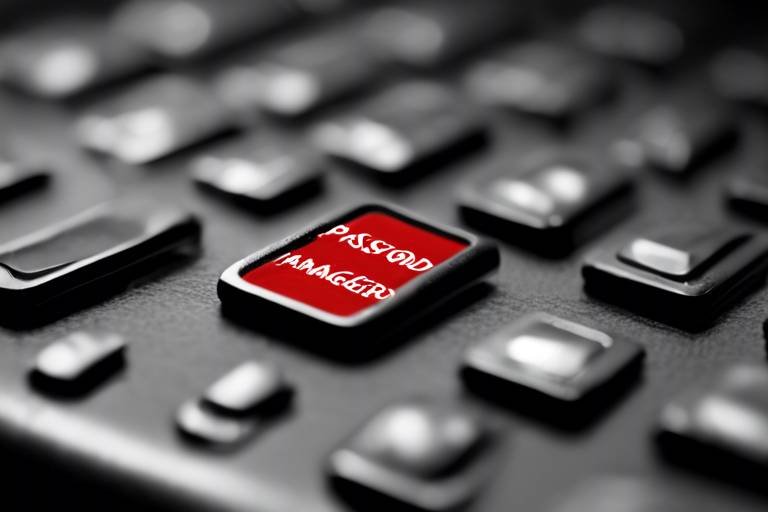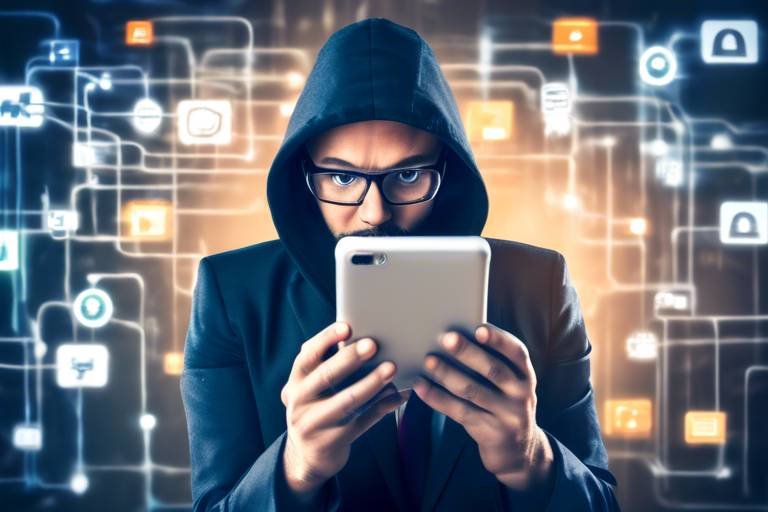How to Deal with Cyberbullying
In today's digital age, the internet has become a double-edged sword. While it connects us and provides endless opportunities for learning and interaction, it also opens the door to a darker reality known as cyberbullying. This article explores effective strategies and resources for addressing cyberbullying, empowering victims, and fostering a safer online environment for everyone involved. If you or someone you know is facing this issue, it’s crucial to understand that you are not alone, and there are steps you can take to combat this harmful behavior.
Cyberbullying is a pervasive issue that affects individuals of all ages. It involves the use of technology to harass, threaten, or humiliate someone, often through social media, messaging apps, or online forums. The forms it can take are varied and can include sending hurtful messages, spreading rumors, or even impersonating someone online. The psychological impact on victims can be devastating, leading to feelings of isolation, anxiety, and depression. It's essential to recognize that the effects of cyberbullying can linger long after the incidents occur, making it a critical issue that needs to be tackled head-on.
Identifying the signs of cyberbullying is crucial for intervention. Victims may exhibit noticeable behavioral changes, such as withdrawing from friends and family, a sudden drop in academic performance, or changes in their online habits. Emotional distress can manifest in various ways, including increased anxiety, depression, or even anger. If you notice someone becoming unusually secretive about their online activities or avoiding social interactions, it may be time to step in and offer support.
Technology plays a significant role in both facilitating and combating cyberbullying. While it can be a tool for connection, it can also empower bullies to act with anonymity and impunity. Understanding how different platforms contribute to this issue is vital for creating a safer online environment.
Different social media platforms have unique features that can either exacerbate or mitigate cyberbullying. For instance, platforms that allow public commenting can become breeding grounds for negative interactions. On the other hand, features like privacy settings and reporting tools can help users protect themselves. It’s crucial for users to familiarize themselves with these characteristics to navigate them more safely.
Messaging apps can provide anonymity, making it easier for bullies to target their victims. The risks associated with these platforms are significant, as they often lack the same level of oversight as social media. Users should be aware of the potential dangers and take proactive steps to safeguard their online interactions. For example, adjusting privacy settings, blocking unwanted contacts, and being cautious about sharing personal information can significantly reduce the risk of becoming a target.
The effects of cyberbullying can be profound and long-lasting. Victims often face emotional turmoil, leading to psychological issues such as depression and anxiety. Social consequences can also arise, as victims may withdraw from social situations, leading to isolation. It’s essential to recognize the seriousness of these impacts and work towards fostering a supportive environment for those affected.
Victims of cyberbullying can take specific steps to protect themselves. Empowering individuals with practical strategies can make a significant difference in their experiences. Here are some effective approaches:
Keeping records of bullying incidents is essential for reporting and seeking help. Victims should take screenshots of harmful messages, save emails, and note the dates and times of incidents. This documentation can be invaluable when approaching authorities or seeking support from friends and family.
Support from friends, family, and professionals can make a significant difference. It’s crucial for victims to reach out and find a supportive network. Whether it’s talking to a trusted friend, seeking guidance from a counselor, or joining online support groups, having a solid support system can alleviate the feelings of isolation that often accompany cyberbullying.
- What should I do if I am being cyberbullied? - Reach out to someone you trust, document the incidents, and consider reporting the behavior to the platform or authorities.
- How can I support a friend who is a victim of cyberbullying? - Listen to them, validate their feelings, and encourage them to seek help. Offer to assist them in documenting the bullying.
- Are there legal actions I can take against cyberbullying? - Yes, many jurisdictions have laws against cyberbullying. Consulting with a legal expert can provide guidance on the options available.

Understanding Cyberbullying
Cyberbullying is more than just a buzzword; it’s a serious issue that can impact anyone, regardless of age. In simple terms, cyberbullying refers to the act of using digital platforms—like social media, messaging apps, or websites—to harass, threaten, or humiliate someone. It’s like being bullied on the playground, but instead of facing your tormentor in person, you’re dealing with their taunts and insults through a screen. This anonymity can make the experience even more daunting for the victim, as the bully may feel emboldened by the distance technology provides.
There are various forms of cyberbullying, including but not limited to:
- Harassment: Repeatedly sending offensive messages.
- Impersonation: Pretending to be someone else to damage their reputation.
- Outing: Sharing private information without consent.
- Exclusion: Intentionally excluding someone from online groups or activities.
- Flaming: Posting inflammatory comments to provoke others.
The psychological impact of cyberbullying is profound and can lead to a range of emotional issues for victims. Imagine waking up every day to find hurtful messages waiting for you, or seeing your friends turn against you online. It’s not just a bad day; it can lead to severe anxiety, depression, and even suicidal thoughts in extreme cases. Victims often feel isolated, believing they are the only ones experiencing this torment, which can exacerbate their feelings of helplessness.
Moreover, the effects of cyberbullying can extend beyond the individual. Families, friends, and even communities can feel the ripple effects of this digital aggression. It’s crucial to understand that cyberbullying isn’t just a phase or something that kids will "get over." The scars it leaves can last a lifetime, making it essential for everyone—parents, educators, and peers—to recognize and address this issue head-on.
In conclusion, understanding cyberbullying is the first step towards combating it. By recognizing its forms, acknowledging its impact, and fostering open conversations about it, we can create a safer online environment for everyone. The digital world should be a place for connection and creativity, not a breeding ground for fear and anxiety. So, let’s stand together against cyberbullying and empower each other to speak out and seek help.

Recognizing the Signs
When it comes to cyberbullying, the signs can sometimes be subtle, making it difficult for friends, family, and even the victims themselves to recognize what's happening. It's essential to stay vigilant and aware of the indicators that someone may be suffering in silence. Behavioral changes are often the first red flags. For example, if a typically outgoing person suddenly becomes withdrawn or starts avoiding social interactions, it could be a sign that they are experiencing bullying online. It's like watching a vibrant flower lose its petals; something is wrong, and it's crucial to investigate further.
Another significant indicator is emotional distress. If you notice someone frequently displaying signs of anxiety, depression, or mood swings, it might be time to dig a little deeper. Victims of cyberbullying often feel trapped and helpless, which can manifest in various ways, including:
- Increased irritability or anger
- Frequent crying spells
- Loss of interest in activities they once enjoyed
In addition to emotional changes, physical symptoms can also arise. Victims may complain of headaches, stomachaches, or other unexplained ailments. This connection between mental and physical health is crucial; stress and anxiety can take a toll on the body, just like a heavy backpack can wear you down over time. If you notice someone frequently feeling unwell without a clear medical reason, it could be a sign of deeper issues.
Moreover, changes in online behavior can be telling. If a person suddenly stops using their social media accounts, deletes friends, or changes their privacy settings, it might indicate they're trying to protect themselves from online harassment. It's similar to someone pulling the curtains closed in their home; they’re seeking safety from the outside world. Pay attention to these digital footprints, as they can lead to a better understanding of what someone might be going through.
Finally, don't overlook the importance of communication. If someone confides in you about negative experiences online, take it seriously. Even if it seems minor, dismissing their feelings can make them feel even more isolated. Just like a small crack in a dam can lead to a massive flood, ignoring the signs can escalate the situation. Always encourage open dialogue and let them know they are not alone.
In summary, recognizing the signs of cyberbullying involves a combination of observing behavioral changes, emotional distress, physical symptoms, changes in online habits, and maintaining open communication. By being attentive and supportive, you can help those affected feel less isolated and more empowered to seek help.
Q: What should I do if I suspect someone is being cyberbullied?
A: If you suspect someone is being cyberbullied, approach them gently and express your concern. Encourage them to share their experiences, and offer your support. If necessary, help them report the bullying to the appropriate authorities or platforms.
Q: How can I protect myself from becoming a victim of cyberbullying?
A: To protect yourself, be mindful of the information you share online. Adjust your privacy settings, be cautious about friend requests, and think before you post. Surround yourself with a supportive network and know that it’s okay to seek help if you feel threatened.
Q: Are there legal consequences for cyberbullying?
A: Yes, many jurisdictions have laws against cyberbullying. Depending on the severity of the actions, consequences can range from warnings to criminal charges. It’s essential to understand the laws in your area and take appropriate action if needed.

The Role of Technology
In today's digital age, technology is a double-edged sword when it comes to cyberbullying. On one hand, it has provided us with incredible tools for communication and connection; on the other hand, it has also created new avenues for harassment and abuse. Understanding this dynamic is crucial for anyone navigating the online world. Just think about it: every time you log into your favorite social media platform or messaging app, you’re stepping into a space that can be both welcoming and hostile.
Social media platforms have become a breeding ground for cyberbullying due to their inherent nature of rapid communication and wide reach. With just a few clicks, a post or comment can go viral, spreading hurtful messages to countless individuals in mere seconds. This phenomenon is exacerbated by the anonymity that the internet provides. Bullies can hide behind fake profiles, making it easier for them to target victims without facing immediate repercussions. For instance, a simple tweet can escalate into a full-blown online attack, leaving the victim feeling isolated and helpless.
Moreover, messaging apps, which are designed for private communication, can also facilitate cyberbullying. Many of these apps allow users to create groups or send direct messages, providing a level of privacy that can embolden bullies. The anonymity associated with these platforms often leads to a false sense of security for the perpetrators. They might think, “I can say whatever I want without facing any consequences.” Unfortunately, this mindset can have devastating effects on the victims, who may feel trapped and unable to escape the harassment.
To illustrate the impact of technology on cyberbullying, let’s take a look at some statistics:
| Platform | Percentage of Users Reporting Cyberbullying |
|---|---|
| 30% | |
| 25% | |
| Snapchat | 20% |
| 15% |
These figures highlight how prevalent cyberbullying is across various platforms. Each social media site has its unique features that can either exacerbate or mitigate the problem. For example, platforms that allow for public comments can quickly turn into arenas for bullying, while those that focus on private messaging can lead to more covert forms of harassment.
As users, it’s essential to be aware of these dynamics and take proactive steps to protect ourselves and others. This includes understanding the risks associated with each platform and using privacy settings to control who can see our posts and interact with us. By being informed, we can create a safer online community where everyone feels respected and valued.

Social Media Platforms
Social media platforms have become a double-edged sword in the realm of communication and interaction. While they offer a space for connection and expression, they also provide a fertile ground for cyberbullying to thrive. Understanding how these platforms operate is crucial for users, especially when it comes to protecting themselves from potential harm. Each platform has its own unique features that can either amplify or mitigate the risks associated with cyberbullying.
For instance, platforms like Facebook and Instagram allow users to share personal information, images, and posts, which can sometimes lead to unwanted attention or harassment. The public nature of these posts can make it easier for bullies to target individuals, often leading to a cycle of negativity that can be hard to escape. On the other hand, features like privacy settings and blocking options provide users with tools to safeguard their online presence.
Similarly, platforms such as Twitter can facilitate rapid communication, but they also enable the spread of harmful content at lightning speed. The character limit encourages brevity, which can sometimes lead to misunderstandings or misinterpretations that escalate into bullying situations. Moreover, the anonymity offered by some accounts can embolden bullies, making it easier for them to attack without facing immediate consequences.
To navigate these challenges effectively, users should be aware of the following strategies:
- Utilize privacy settings to control who can see your posts and interact with you.
- Be selective about the information you share publicly; consider the long-term implications of your digital footprint.
- Engage with communities that promote positivity and support, as these can serve as safe havens.
In essence, while social media platforms can be a source of joy and connection, they also come with inherent risks that users must navigate carefully. By understanding the dynamics of each platform and employing safety measures, individuals can enjoy their online experiences while minimizing the threat of cyberbullying.
What is cyberbullying?
Cyberbullying refers to the use of digital communication tools to harass, threaten, or intimidate individuals, often resulting in emotional distress and social isolation.
How can I recognize if someone is being cyberbullied?
Signs of cyberbullying may include sudden changes in behavior, withdrawal from social interactions, and unexplained emotional distress. If you notice these signs in someone, it’s essential to talk to them and offer support.
What should I do if I am a victim of cyberbullying?
If you're experiencing cyberbullying, it's crucial to document the incidents, seek support from trusted friends or family, and consider reporting the behavior to the platform or authorities.
Can social media platforms help prevent cyberbullying?
Yes, many social media platforms have implemented features like blocking, reporting, and privacy settings to help users protect themselves. However, it's up to the users to utilize these tools effectively.

Messaging Apps
In today's digital age, have become a cornerstone of communication, especially among younger generations. These platforms, such as WhatsApp, Snapchat, and Facebook Messenger, allow users to connect instantly, sharing thoughts, images, and videos with just a few taps. However, this convenience comes with a dark side: the potential for cyberbullying. The anonymity and immediacy that messaging apps provide can create a breeding ground for bullies, making it easier for them to target victims without facing any immediate consequences.
One of the primary reasons messaging apps can facilitate cyberbullying is their ability to offer a sense of anonymity. Users can create accounts without revealing their true identities, allowing them to engage in harmful behaviors without fear of being caught. This anonymity can embolden bullies to send hurtful messages, share embarrassing photos, or spread rumors. In fact, research shows that individuals are more likely to engage in aggressive behavior when they feel anonymous. The lack of face-to-face interaction also diminishes the emotional impact of their words, making it easier for bullies to disregard the feelings of their victims.
Moreover, many messaging apps have features that can exacerbate the situation. For instance, the ability to send messages in groups or create private chats can lead to exclusion and gossip. Victims may find themselves ostracized from group conversations, leading to feelings of isolation and despair. Furthermore, the ephemeral nature of messages on platforms like Snapchat can make it challenging for victims to keep records of bullying incidents, complicating matters when they seek help. The fleeting nature of these messages can also provide bullies with a false sense of security, thinking they can engage in harmful behavior without leaving a trace.
To combat the risks associated with messaging apps, it’s crucial for users to be aware of their settings and privacy options. Here are some strategies to enhance safety:
- Adjust Privacy Settings: Most messaging apps allow users to control who can send them messages or view their profiles. Take the time to review and adjust these settings to limit interactions to trusted contacts.
- Block and Report: If you encounter bullying behavior, don’t hesitate to block the individual and report their actions to the app’s support team. This can help prevent further harassment and protect others from similar experiences.
- Think Before You Share: Always consider the potential consequences of sharing personal information or images. Once something is shared digitally, it can be difficult to control where it ends up.
In conclusion, while messaging apps can enhance our ability to connect, they can also serve as platforms for cyberbullying. By understanding the risks and taking proactive measures, users can help create a safer online environment for themselves and others. Remember, it’s not just about how we communicate, but also about how we treat each other in the digital world.

Impact on Victims
The effects of cyberbullying can be profound and long-lasting, leaving emotional scars that may not be visible to the naked eye. Victims often experience a range of psychological impacts that can affect their daily lives, self-esteem, and overall mental health. Imagine waking up each day with a cloud of anxiety hanging over you, unsure of what kind of messages you might receive. This is the reality for many individuals who face cyberbullying.
One of the most immediate impacts is the feeling of isolation. Victims may withdraw from social interactions, fearing judgment or further harassment. It's as if they are trapped in a bubble, surrounded by people yet feeling completely alone. This isolation can lead to deeper issues such as depression and anxiety disorders, which can linger long after the bullying has stopped.
Furthermore, the psychological toll of cyberbullying can manifest in physical symptoms. Victims may experience headaches, stomachaches, and sleep disturbances as their minds grapple with the stress and fear associated with online harassment. This is not just a mental battle; it takes a toll on their physical health as well.
To illustrate the impact more clearly, consider the following table that outlines some common psychological effects and their potential consequences:
| Psychological Effect | Potential Consequences |
|---|---|
| Low Self-Esteem | Withdrawal from social activities, increased vulnerability to further bullying |
| Anxiety | Difficulty concentrating, panic attacks, avoidance of certain situations |
| Depression | Loss of interest in hobbies, changes in appetite, thoughts of self-harm |
| Post-Traumatic Stress | Flashbacks, nightmares, emotional numbing |
In addition to these psychological impacts, the social consequences can be equally damaging. Victims may find it difficult to trust others, leading to strained relationships with friends and family. The fear of being bullied can make it hard for them to engage fully in school, work, or social settings, creating a cycle of avoidance that further exacerbates their feelings of loneliness and despair.
Ultimately, the impact of cyberbullying extends beyond the individual. It creates a ripple effect that can affect friends, families, and entire communities. When someone is bullied online, it can foster an environment of fear and mistrust, making it crucial for everyone to take a stand against such behavior. Remember, the scars of cyberbullying may not be visible, but they are very real and can last a lifetime.
- What should I do if I witness cyberbullying? - It's important to speak up and report the behavior to the appropriate authorities, whether that be school officials or social media platforms.
- Can cyberbullying happen to adults? - Yes, cyberbullying can affect individuals of all ages, including adults in professional settings.
- How can I support someone who is being cyberbullied? - Offer a listening ear, encourage them to document incidents, and help them seek professional support if needed.

Strategies for Victims
Dealing with cyberbullying can feel like navigating a maze without a map. It's confusing, overwhelming, and often leaves victims feeling isolated. However, there are effective strategies that can empower individuals to take back control of their online experience. First and foremost, it's crucial for victims to understand that they are not alone; many people face similar challenges, and there are resources available to help.
One of the most important steps a victim can take is to document every incident. This means keeping a detailed record of the bullying, including screenshots, messages, and any other relevant information. Not only does this documentation serve as evidence when reporting the abuse, but it also helps victims to process their experiences. It can be therapeutic to articulate what happened, and it can provide clarity in a chaotic situation. For those unsure of how to document effectively, consider the following tips:
- Take screenshots of messages, posts, or comments that are hurtful.
- Keep a log of dates, times, and descriptions of incidents.
- Save any relevant emails or texts that illustrate the bullying behavior.
Another vital strategy is to seek support. Whether it’s talking to friends, family, or professionals, having a support network can make a world of difference. Victims should not hesitate to reach out to those they trust. Sharing feelings and experiences can alleviate the weight of the situation and provide emotional relief. Moreover, support groups, whether online or in-person, can connect victims with others who understand their struggles. Here’s how to find support:
- Look for local or online support groups focused on bullying or mental health.
- Talk to a trusted adult or counselor who can provide guidance.
- Utilize online forums or communities where individuals share their experiences.
Additionally, victims should consider blocking and reporting the bullies on social media and messaging platforms. Most platforms have mechanisms in place to handle harassment and bullying, which can help stop the abuse. By reporting the behavior, victims not only protect themselves but also help create a safer environment for others. It’s essential to familiarize oneself with the reporting guidelines of each platform, as they can vary significantly.
Finally, it’s important for victims to prioritize their mental health. Engaging in activities that promote well-being can be incredibly beneficial. This could include hobbies, exercise, or mindfulness practices. By focusing on self-care, victims can build resilience and better cope with the emotional toll of cyberbullying. Remember, it’s okay to seek professional help if the situation feels too overwhelming. Therapists and counselors can provide coping strategies tailored to individual needs.
In summary, while the journey through cyberbullying can be tough, victims have the power to reclaim their narrative. By documenting incidents, seeking support, utilizing platform tools, and prioritizing mental health, individuals can navigate this difficult landscape with strength and resilience.
Q: What should I do if I see someone being cyberbullied?
A: If you witness cyberbullying, it's crucial to intervene safely. You can support the victim by reaching out to them privately, encouraging them to document the incidents, and reporting the bully to the appropriate platform or authority.
Q: How can I help a friend who is a victim of cyberbullying?
A: Be a good listener and offer emotional support. Encourage them to talk about their feelings and experiences. Help them document the bullying and suggest they seek professional help if needed.
Q: Is it okay to confront the bully directly?
A: While it might be tempting to confront the bully, it's often safer to avoid direct interaction. Instead, focus on documenting the behavior and reporting it to the platform or authorities.
Q: Can cyberbullying have long-term effects?
A: Yes, the effects of cyberbullying can be profound and long-lasting, potentially leading to anxiety, depression, and other mental health issues. Seeking help from professionals can mitigate these effects.

Documenting Evidence
When it comes to dealing with cyberbullying, one of the most important steps a victim can take is . This process is not just about saving screenshots or messages; it’s about creating a comprehensive record that can help in reporting the incident and seeking support. Imagine trying to prove a point in a debate without any facts or figures—it's nearly impossible! Similarly, without solid documentation, it can be challenging to make your case to authorities, schools, or even parents.
First and foremost, it’s essential to keep a detailed log of all incidents. This includes dates, times, and the nature of the interactions. For example, if someone sends you hurtful messages on social media, note the exact time and date it occurred. This timeline becomes invaluable when you need to present your case. Additionally, consider capturing the context of the conversation. Was it a private message, a comment on a post, or a group chat? Each detail adds weight to your documentation.
Next, screenshots are your best friends in this situation. Take clear screenshots of any abusive messages, posts, or comments. Make sure to include the usernames and timestamps in these images, as this will help establish a clear narrative of what has transpired. It's also a good idea to save these images in a dedicated folder on your device, so they are easily accessible when needed. Remember, the more organized you are, the easier it will be to present your case.
Furthermore, if the bullying occurs through text messages or emails, consider using a similar approach. Save the entire conversation thread, not just the most hurtful messages. Context is key, and having the full conversation can help illustrate the pattern of bullying behavior. If you’re unsure how to save these messages, here’s a quick guide:
- For text messages, you can use apps that back up your messages or take screenshots.
- For emails, use the 'Print' option and save as PDF to keep a record.
In addition to saving digital evidence, consider documenting any emotional or psychological effects you experience as a result of the bullying. Keeping a journal can be a therapeutic way to process your feelings and also serves as a record of how the bullying impacts your daily life. This can be particularly helpful if you decide to seek professional help later on.
Lastly, don’t hesitate to reach out to trusted individuals for support. Sharing your experiences with friends or family can provide emotional relief and may even lead to additional documentation if they witness the bullying firsthand. Remember, you are not alone in this fight, and having a support system can make a world of difference.
In summary, documenting evidence is a crucial step in combating cyberbullying. By keeping a meticulous record of incidents, collecting screenshots, and noting the emotional toll, victims can empower themselves to take action. Just like a detective gathering clues to solve a mystery, you are piecing together the evidence needed to confront the situation head-on.
- What should I do if I witness cyberbullying? If you see someone being bullied online, it's important to report it to the platform and support the victim by reaching out to them privately.
- Can I report cyberbullying to law enforcement? Yes, if the bullying involves threats or harassment, you should report it to local law enforcement.
- How can I support a friend who is being bullied? Be there to listen, encourage them to document the bullying, and help them seek professional support if needed.

Seeking Support
When it comes to dealing with the emotional turmoil of cyberbullying, reaching out for support is not just important—it's essential. Imagine trying to climb a mountain alone; the weight of the world feels heavier without a trusty companion by your side. The same goes for navigating the choppy waters of online harassment. Victims often feel isolated, but connecting with others can provide the much-needed buoyancy to keep them afloat. Whether it's friends, family, or professional counselors, having a support system can make a world of difference.
First and foremost, it’s vital to talk to someone you trust. This could be a close friend who understands what you’re going through or a family member who can offer guidance and comfort. Sharing your experiences can be incredibly cathartic, allowing you to vent frustrations and fears. It’s like releasing a pressure valve; suddenly, the burden feels a little lighter. Don’t underestimate the power of a listening ear!
In addition to personal connections, consider seeking professional help. Therapists and counselors are trained to handle the complexities of emotional distress caused by bullying. They can provide you with coping strategies tailored to your situation. Think of them as your personal trainers for emotional resilience, helping you build strength and confidence to face the challenges ahead. If you're unsure where to find help, many online platforms offer therapy sessions, making it easier than ever to access support from the comfort of your home.
Support groups can also be a fantastic resource. These groups often consist of individuals who have faced similar experiences, creating a safe space for sharing and healing. It’s reassuring to know that you’re not alone in this battle. You might even forge new friendships that extend beyond the group setting, giving you a network of support that can last a lifetime. Look for local or online support groups that focus on cyberbullying and mental health; they can be a goldmine of encouragement and understanding.
Here’s a quick overview of where to seek support:
- Friends and Family: Start with those who know you best.
- Professional Counselors: Seek therapy for personalized guidance.
- Support Groups: Join communities for shared experiences and encouragement.
- Online Resources: Utilize websites and hotlines dedicated to cyberbullying support.
Finally, don’t forget the power of advocacy. Many organizations are dedicated to combating cyberbullying and can provide resources, workshops, and even legal advice if necessary. Engaging with these organizations not only helps you but also contributes to a larger movement aimed at creating safer online spaces for everyone. Remember, seeking support is a sign of strength, not weakness. You are taking proactive steps towards healing and empowerment, and that’s something to be proud of!
Q: What should I do if I see someone being cyberbullied?
A: If you witness cyberbullying, it's important to report it to the platform where it’s happening. Additionally, reach out to the victim and offer your support. Let them know they are not alone.
Q: How can I help a friend who is being cyberbullied?
A: Listen to them without judgment, encourage them to document incidents, and suggest they seek professional help if needed. Your support can make a significant difference in their recovery.
Q: Are there legal actions I can take against cyberbullies?
A: Yes, depending on the severity of the bullying, there may be legal options available. Consult with a legal expert who specializes in cyberbullying cases to understand your rights.
Q: Can cyberbullying affect mental health?
A: Absolutely. Cyberbullying can lead to anxiety, depression, and other mental health issues. Seeking support and professional help is crucial for those affected.
Frequently Asked Questions
- What is cyberbullying?
Cyberbullying is a form of bullying that takes place over digital devices like computers, smartphones, and tablets. It can involve sending, posting, or sharing negative, harmful, false, or malicious content about someone. This can occur through social media, messaging apps, or online forums, making it a pervasive issue that can affect anyone, regardless of age.
- How can I recognize if someone is being cyberbullied?
Look for signs such as sudden changes in behavior, withdrawal from social activities, or emotional distress. If someone becomes unusually quiet, anxious, or starts avoiding their devices, these could be indicators that they are experiencing cyberbullying. It's important to pay attention to these changes and offer support.
- What should I do if I witness cyberbullying?
If you see someone being bullied online, it’s crucial to take action. You can report the behavior to the platform where it’s happening, reach out to the victim to offer support, and encourage them to document the incidents. Your involvement can make a significant difference in stopping the bullying.
- Can technology help combat cyberbullying?
Absolutely! Many social media platforms and messaging apps have implemented features that allow users to block or report bullies. Additionally, there are various apps and tools designed to help monitor online interactions and provide resources for victims. Technology can be a powerful ally in creating a safer online space.
- What are some effective strategies for victims of cyberbullying?
Victims should document all incidents of bullying, including screenshots and messages. Seeking support from friends, family, or professionals is also vital. It's important to remember that they are not alone, and there are people willing to help them through this tough time.
- How can I support a friend who is being cyberbullied?
Be there for them! Listen to their concerns without judgment and encourage them to talk about their feelings. Offer to help them document the bullying and suggest they seek professional help if needed. Just knowing that someone cares can make a world of difference.
- Are there legal actions that can be taken against cyberbullies?
Yes, in many jurisdictions, cyberbullying can be considered a criminal offense. Victims can report the behavior to law enforcement, especially if it involves threats, harassment, or stalking. It's essential to understand the laws in your area and seek legal advice if necessary.



















